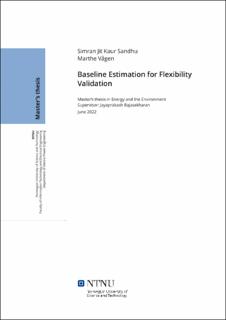Baseline Estimation for Flexibility Validation
Master thesis
Permanent lenke
https://hdl.handle.net/11250/3024851Utgivelsesdato
2022Metadata
Vis full innførselSamlinger
- Institutt for elkraftteknikk [2465]
Sammendrag
For å håndtere utfordringer fra ukontrollerbare energiressurser og implementering av distribuerteenergiressurser, krever distribusjonssystemoperatører fleksible laster og energikilder som hjelper balanseringen av elektrisk energiforsyning og etterspørsel. En aggregator, som fungerer somen mellommann, kan kjøpe fleksibilitet fra forbrukere for å så samle dette og selge videre tilen kjøper, som distribusjonssystemoperatører. Oppgjørsprosessen mellom aggregator og distribusjonssystemoperatør krever validering av den aktiverte fleksibiliteten, noe som kan væreutfordrende siden den aktiverte fleksibiliteten ikke fysisk kan måles.
Hovedformålet i denne masteroppgaven inkluderer hvordan distribusjonssystemoperatøren kanvalidere denne etterspørselsside-fleksibiliteten på nettstasjonsnivå aktivert av aggregatoren ioppgjørsprosessen, og hvordan valideringen kan implementeres i et realistisk scenario ved å brukeforbruksdata tilgjengelig for distribusjonssystemoperatøren. Lastprognosemetoder for grunnlinjeestimeringkan brukes til disse formålene, da de estimerer hva forbrukere ville ha konsumert ifravær av fleksibilitetsaktivering. To regresjonsmetoder ble foreslått i denne oppgaven: kunstignevrale nettverk og flerlineær regresjon.
To strategier ble implementert med regresjonsmetodene: rekursiv og korrigerende. Den rekursivestrategien ble valgt for å forbedre estimeringsresultatene og få simuleringene til å reflektere etvirkelighetsscenario, da kun data tilgjengelig for distribusjonssystemoperatøren ble brukt. Denkorrigerende strategien ble implementert for å forbedre nøyaktigheten til den rekursive strategien.Det ble brukt kunstig nettstasjonsdata med både 1 og 5 minutters frekvens. Grunnlinjeestimeringav individuelle husholdninger ble også utført for å undersøke om mer informasjonangående fleksibilitetsvalideringen kunne bestemmes på et lavere nivå.
Implementeringen av den rekursive strategien viste mer nøyaktige resultater i kunstig nevralenettverk enn flerlineær regresjon. Begge metodene fulgte trenden til den faktiske grunnlinjen,men ingen av metodene var i stand til å fange opp den høye fluktuerende frekvensen. Denkorrigerende strategien forbedret estimeringsresultatene til en viss grad. Nøyaktigheten av metodeneetter implementering av strategiene er moderat. Det er imidlertid rom for forbedringer ifremtiden ved å blant annet bruke passende forklaringsvariabler og avanserte maskinlæringsalgoritmer.
Frekvensjusteringen hadde lite eller noe betydning for nøyaktigheten til metodene, og ingenav de to frekvensene vil derfor være mer gunstige for distribusjonssystemoperatøren. Sidengrunnlinjeestimering er utfordrende på boligdata, kan bidraget fra de enkelte husestimatenevære ubetydelig for distribusjonssystemoperatøren i oppgjørsprosessen.
Kompleksiteten til validering ved bruk av grunnlinjeestimering er bevist, der selv de vanligsteregresjonsmetodene mislykkes på grunn av problemets natur. Videre arbeid bør undersøkefaktorene som påvirker strategiene og undersøke ulike strategier. To deal with challenges posed by intermittent energy resources and the implementation of distributedenergy resources, distribution system operators require flexible loads and energy sourcesthat support the balancing of electrical energy supply and demand. An aggregator, acting asan intermediary, may purchase flexibility from consumers to aggregate and sell to a buyer, suchas distribution system operators. The settlement process between aggregator and distributionsystem operator requires validation of the activated flexibility, which can be challenging as thisactivated flexibility can not be physically measured.
The main research question of this thesis includes how the distribution system operator can validatethis demand-side flexibility at substation level activated by the aggregator in the settlementprocess and how validation can be implemented in a realistic scenario using consumption dataavailable to the distribution system operator. Load forecasting methods for baseline estimationcan be implemented for this purpose, as they estimate what consumers would have consumedin the absence of flexibility activation. Two regression methods were proposed in this thesis:artificial neural network and multiple linear regression.
Two strategies were implemented with the regression methods: recursive and rectifying. Therecursive strategy was chosen to improve the estimation results and make the simulations reflecta real-world scenario, as only data available to the distribution system operator was used.The rectifying strategy was implemented to improve the accuracy of the recursive strategy.Artificially created substation data with both 1 and 5-minute frequency were used. Baselineestimation of individual households was also conducted to examine whether more informationregarding the flexibility validation could be determined at a lower level.
The implementation of the recursive strategy showed more accurate results in artificial neuralnetwork than multiple linear regression. Both methods followed the trend of the actual baseline,but neither method was able to capture the high fluctuating frequency. The rectifying strategyimproved the baseline estimation results to some degree. The accuracy of the methods afterimplementing the strategies is moderate. However, it has scope for improvement in the futureby using appropriate explanatory variables and advanced machine learning algorithms, amongother factors.
The frequency adjustment had little or some effect on the accuracy of the methods, and neitherof the two frequencies might therefore be more favorable for the DSO. As baseline estimationis challenging on residential data, the contribution from the individual house estimations mightbe negligible to the DSO in the settlement process.
The complexity of validation using baseline estimation has been proven, where even the mostcommon regression methods fail due to the nature of the problem. Further work should researchthe factors affecting the strategies and examine different strategies.
